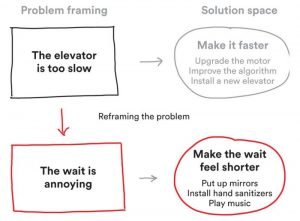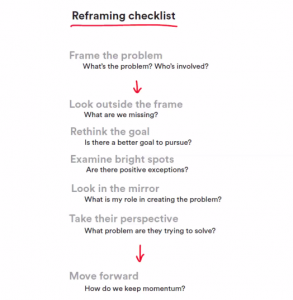Today on Unleashed we are joined by Thomas Wedell-Wedellsborg. Thomas is the author of What’s Your Problem?, a book on how to solve the right problems. He is also the co-author (with Paddy Miller) of Innovation as Usual, a Harvard Business Review Press book on the art of driving innovation in regular organizations. Thomas has worked with managers in nearly all parts of the globe. His research has been featured in Harvard Business Review, The Sunday Times, The Telegraph, BBC Radio, Bloomberg Businessweek and the Financial Times.
His work on innovation led HR Magazine to recognize him as a “Top 20 International Thinker”. As an executive advisor and keynote speaker, Thomas has addressed organizations such as Cisco, Microsoft, Citigroup, Time Warner, Caterpillar, Amgen, Prudential, Union Pacific, Credit Suisse, Deloitte, the Wall Street Journal, and the United Nations. Thomas holds an MA in Media Science from the University of Copenhagen and an MBA from IESE Business School. Prior to his business career, Thomas served for four years as an officer with the Danish Royal Guards.
Working with Problems
Thomas spent 18 months researching problem-solving in organizations and writing his book and shockingly discovered that 85% of CEOs report that significant time and money is being spent on solving the wrong problems. When asked why, Thomas points to the fact that we learn through our education and career how to solve problems, but we never learn how to find, expand, or explore problems before solving them; most people don’t ask, “are we solving the right problem?” before jumping to solution mode.
 He shared an instructive example. A landlord in an office building was receiving complaints that the elevators were to slow. On first blush, we would assume the solution would be to spend significant funds to increase the speed of the elevators. However, savvy landlords recognize that the problem is not, in fact, the speed of the elevator but how people feel when they must wait for it to arrive which could be solved in many ways. One solution which has proven effective is to install mirrors in the foyers so that people can look at themselves, be distracted (by how great they look), and not notice the wait.
He shared an instructive example. A landlord in an office building was receiving complaints that the elevators were to slow. On first blush, we would assume the solution would be to spend significant funds to increase the speed of the elevators. However, savvy landlords recognize that the problem is not, in fact, the speed of the elevator but how people feel when they must wait for it to arrive which could be solved in many ways. One solution which has proven effective is to install mirrors in the foyers so that people can look at themselves, be distracted (by how great they look), and not notice the wait.
Three Steps to Solving Problems
Thomas introduced a powerful yet simple approach to problem-solving that defines three sequential steps:
- Frame the Problem
- Framing involves specifically writing down what the problem is. Issues, situations are problems are nebulous and subjective, so writing them down often separates the people and emotions from the problems and allows for more rational thinking.
- For many issues, get a group involved is important, and as Alison Fragale showed us, diversity and process for the group is key to productivity.
- Watch for emotional language in framing – it is often misleading and creates interference in finding the best solution.
- Look for external input to validate the problem exists. Companies sometimes make the mistake by creating products and services that if they’d concept tested sooner, they would have found that customers would not pay for that.
- Reframe the Problem
- Again, before moving to solution mode, look at stating the problem in different ways.
- Questions matter (see below).
- Brainstorm with the group.
- Move Forward
- When a solution path is selected, be willing to experiment further.
- Confirm externally, e.g., check that customers recognize the problem, and would pay to solve it.
- Companies often focus on optimizing to serve existing customers, when the greatest opportunities often lay with unserved parts of the market (e.g. Paypal servicing small funds transfers without lengthy security requirements that the banks had).
In many organizations, there may be initial resistance to introducing a process like this that seems to be slow. If faced with that, try telling the elevator story above, or cite the Apple versus Nokia story.
Powerful Questions for Reframing
Thomas suggested that the reframing step in the process above is the least familiar for people and can be the greatest opportunity for improvement. He introduced these points of inquiry to find problem reframing alternatives:
- Look outside the frame
 The tendency is to go deep into the detail. Good problem solvers take a step back and ask, “what are we missing here?”
The tendency is to go deep into the detail. Good problem solvers take a step back and ask, “what are we missing here?”- Jumping to the ‘root cause’ of the problem assumes that problems have only one real cause, but most are multi-causal. That’s good, that means there are many ways to think about them and solve them.
- Rethink the goal
- Ask, “what does success look like?” that may lead to, “is there a better goal to pursue?” There might be a better different timeframe in a different timeframe (long versus short term) or an alternate all together.
- An example is an employee who doesn’t like their boss (problem), therefore feels they need to find a new job. A creative solution is to recognize that the boss is not the problem, but working with her is, and that helping the boss find another job is an alternate solution.
- Examining Bright Spots
- People focus on the negative, but every situation has bright spots. When moving to solutions, we have to avoid ‘throwing the baby out with the bathwater.’ There are always bright spots even in bad situations.
- The key question here, “where is the problem not as bad?”
- Look in the mirror
- Ask yourself, ”What is my role? Do I assume I am the victim, and others created the problem?”
- Maybe there is something in MY behaviour that is contributing to the problem.
- Take their perspective
- What is the other person trying to solve (say in a negotiation situation).
- Walk-in their shoes, ask “what does the situation look like from the other person’s point of view?”
Take Your Leadership and Business to the Next Level
Thomas has more links and articles on his website HERE.
At Results we care about your success, we understand how overwhelming it can feel to run a business, and we’re here to help. Reach out to Nicole through our contact form for ways to unleash the potential of your business.
Visit the Unleashed Podcast Library where you’ll find exclusive conversations with world-class thought leaders, authors, and leadership experts.
Each episode of Unleashed is hosted by Results’ CEO Jeff Tetz who spends most of his day exploring what makes high performers tick and helping build a community of leaders who want to learn and grow together. Follow Jeff (Twitter; LinkedIn; Instagram) for more great leadership insights.


